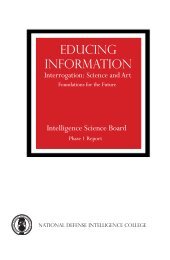COURTING A RELUCTANT ALLY - National Intelligence University
COURTING A RELUCTANT ALLY - National Intelligence University
COURTING A RELUCTANT ALLY - National Intelligence University
- No tags were found...
Create successful ePaper yourself
Turn your PDF publications into a flip-book with our unique Google optimized e-Paper software.
of shoring up their strategic weaknesses. 83 By early 1938, secret talks betweenthe world’s two most powerful navies, conducted with the full approval of theirrespective governments, signaled the beginning of a series of intelligence cooperationand information exchange initiatives by the British to secure U.S. assistancein accomplishing their strategic objectives.Precursor <strong>Intelligence</strong> Exchanges in The Interwar Period: 1920-1935As he looked back on the early 1920s, Rear Admiral Royal Ingersoll, whoplayed a pivotal role in the establishment of closer relations between the U.S.and British navies in 1938, remembered that relations with the British weregenerally cordial, although he could not recall specific details of any intelligenceexchanges with the British during his time at ONI. 84 Another observer,Alan Harris Bath, a former Naval intelligence officer and the author of Trackingthe Axis Enemy, finds that most of the cooperation during this period “consistedmainly of low-level operational exchanges carried out informally by Americanor British naval officers in the fleet or by naval attachés on foreign station.”85 Although there are indications of at least one formal meeting betweenrepresentatives of the two navies in 1928 to discuss views on the Far East situationand the potential for cooperation, the present author’s review of archivaldata supports Bath’s assessment. 86 For example, information requests from theU.S. naval attaché in London to the NID show that the information exchangesbetween the two countries were very routine during this period. They includedrequests for information on such things as British naval pay scales, informationon the pilots and equipment of the British “Fleet Air Arm,” lists of shipsremoved from the Royal Navy active roster, lists of Royal Navy ships laiddown and undergoing modernization, the practice and use of wireless telegraphy(W/T), information on W/T technology, coatings used for aircraft carrierdecks, and deep-sea diving technology. In almost every case, these requests forinformation were framed as a “quid pro quo,” with the U.S. naval attaché offeringto provide similar information to the NID, if the NID honored the attaché’s83Lawrence Pratt, “Anglo-American Naval Conversations,” International Affairs 47 (October1972): 749, 754-758; Bath, 11-12; Coles, 114; Aldrich, 116, 122-124; Charmley, 58.84Ingersoll Reminiscences, 47. RADM Ingersoll worked the ONI Japan desk from 1921 to1924.85Bath, 10.86Dorwart, Conflict of Duty, 140; Bath, 10.26
















